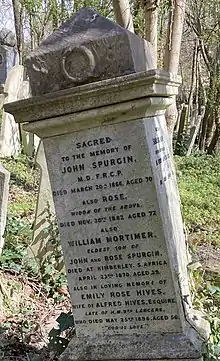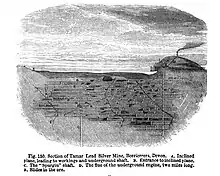John Spurgin
John Spurgin (1796–1866) was an English physician. He is known as a medical writer, inventor, and follower of the works of Emanuel Swedenborg.
Life
The son of William Spurgin, a farmer, he was born at Orplands, Bradwell-on-Sea, Essex.[1][2] His father was a landowner and lord of the manor at nearby Brightlingsea.[3]
Spurgin was educated at Chelmsford grammar school from 1804.[1] At some point he served a medical apprenticeship, with a doctor in Richmond, Yorkshire. There, in 1812, he met the Swedenborgian and army officer George Blakiston Robinson, maternal uncle of James John Garth Wilkinson;[3][4] Spurgin early studied the works of Emanuel Swedenborg, whose ideas he gradually adopted.[1] He was a pupil at St Thomas's Hospital 1813–15.[1] William Charles Wells in 1813 was there, expounding on beauty and progress, natural selection and racial theory.[5]
On 3 July 1814, Spurgin was admitted to Caius College, Cambridge.[2] Before he took up his place, he wrote in 1815 to John Keats, giving in a long letter an exposition of Swedenborg's views.[6] They were acquainted by this time;[7] Keats had then, in late 1815, just begun medical studies at Guy's Hospital, and he and Spurgin had briefly both been dressers together at Guy's.[3] Internal evidence in the letter shows that they both, briefly, were staying at the time it was written in St Thomas Street, by St Thomas's Hospital.[8]
Spurgin was a scholar from Michaelmas 1815 when he matriculated at Caius College, to Michaelmas 1816. He went to Edinburgh University, and, returning to Cambridge, graduated M.B. 1820, and M.D. 1825. He was admitted an inceptor candidate of the Royal College of Physicians of London on 30 September 1822, a candidate 30 September 1825, and a fellow on 30 September 1826. He was censor in 1829, and conciliarius in 1851–3 and 1862–4. He delivered the Harveian oration in 1851 and the college lectures on materia medica in 1852. Spurgin was physician to the Foundling Hospital from 1835 to his death, and around 1837 became physician to St Mark's Hospital.[1]
With a flourishing private practice, Spurgin was first at 38 Guildford Street, Russell Square, from 1820, and at 17 Great Cumberland Street, Hyde Park, from 1853 to his death. He was injured by thieves in Bishopsgate Street on 20 September 1865; and died at 17 Great Cumberland Street, on 20 March 1866. He is buried on the eastern side of Highgate Cemetery. His portrait hung in the Royal College of Physicians.[1]

Inventor
Spurgin was the inventor and patentee of an "endless ladder", for use in scaffolding, which came into general use. He developed a thermoscope for taking the temperature of the body.[1] He also worked on mining equipment with Percival Norton Johnson.[9] This was at Beer Alston, deep under the River Tamar, with an engine that operated to 1860;[10] a model of the mine was shown at the Great Exhibition 1851.[11]

Works
Spurgin gave a personal account in a lecture read before the Swedenborg Association on 24 February 1847, and published in the same year as A Narrative of Personal Experience concerning Principles advocated by the Swedenborg Association. He also planned an edition of Swedenborg's philosophical works in translation. The only volume published was The Introduction to an Anatomical, Physical, and Philosophical Investigation of the Economy of the Animal Kingdom, with an address to the reader by "Medicus Cantabrigiensis", 1861.[1]
Spurgin's other works were:[1]
- Six Lectures on Materia Medica and its Relation to the Animal Economy, 1853.
- The Physician for All, his Philosophy, Experience, and his Mission, 1855; second curriculum, 1857, dedicated to Lord Palmerston.
- Drainage of Cities, reserving their sewage for use and keeping their rivers clean, 1858.
- The Cure of the Sick not Allopathy nor Homœopathy, but Judgment, 1860.
Family
Spurgin married in 1816 Eliza Walsham Dax (or Walshman), daughter of T. Dax of Acton.[12] His eldest son, John Blick Spurgin (1821–1903), an army officer, was her son.[13][14] He married in 1835 Rose Down (1809/10–1882) of Colney Hatch, who died on 30 November 1882. They had a family of at least six children.[1][15][16]
Notes
- Lee, Sidney, ed. (1898). . Dictionary of National Biography. Vol. 53. London: Smith, Elder & Co.
- "Spurgin, John (SPRN814J)". A Cambridge Alumni Database. University of Cambridge.
- Lines, Richard (1 January 2012). A History of the Swedenborg Society 1810-2010. Lulu.com. p. 28. ISBN 978-1-4710-1274-7.
- Tafel, R. L. (1877). Documents Concerning the Life and Character of Emanuel Swedenborg. Swedenborg Society, British and Foreign. p. 1193.
- Almeida, Hermione De (1991). Romantic Medicine and John Keats. Oxford University Press. pp. 5, 12 and 262. ISBN 978-0-19-506307-3.
- Wunder, Jennifer N. (22 April 2016). Keats, Hermeticism, and the Secret Societies. Routledge. p. 1. ISBN 978-1-317-10939-6.
- Roe, Nicholas (14 September 2012). John Keats. Yale University Press. p. 165. ISBN 978-0-300-19015-1.
- Hinckley, Edward B.; Spurgin, John (1960). "On First Looking into Swedenborg's Philosophy: A New Keats-Circle Letter". Keats-Shelley Journal. 9: 16. ISSN 0453-4387. JSTOR 30209931.
- McDonald, Donald (1951). Percival Norton Johnson: The Biography of a Pioneer Metallurgist. Johnson, Matthey & Co. p. 91.
- Murray, John (1895). A Handbook for Travellers in Devon. J. Murray. p. 222.
- John Murray (1856). A Hand-Book for Travellers in Devon & Cornwall. With maps. pp. 95–96.
- "Married". Bury and Norwich Post. 7 August 1816. p. 4.
- Fox-Davies, Arthur Charles (1895). Armorial Families: A Complete Peerage, Baronetage, and Knightage, and a Directory of Some Gentlemen of Coat-armour, and Being the First Attempt to Show which Arms in Use at the Moment are Borne by Legal Authority. Jack. p. 922.
- "Obituary: Lieutenant-General Sir John Spurgin". Aberdeen Press and Journal. 1 December 1903. p. 4.
- McConnell, Anita. "Spurgin, John (1796–1866)". Oxford Dictionary of National Biography (online ed.). Oxford University Press. doi:10.1093/ref:odnb/26188. (Subscription or UK public library membership required.)
- The Court Magazine and Belle Assemblée. Edward Bull. 1835. p. 274.
External links
- Attribution
![]() This article incorporates text from a publication now in the public domain: Lee, Sidney, ed. (1898). "Spurgin, John". Dictionary of National Biography. Vol. 53. London: Smith, Elder & Co.
This article incorporates text from a publication now in the public domain: Lee, Sidney, ed. (1898). "Spurgin, John". Dictionary of National Biography. Vol. 53. London: Smith, Elder & Co.